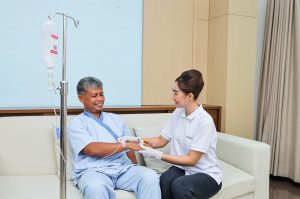There are many types and variations of lying positions for patients, each with its own benefits and purposes depending on the patient’s condition. One of the most common positions is the Supine position.
Read more about the benefits, advantages, and variations of the Supine position below.
What is the Supine Position?
The supine position refers to the patient lying on their back with their face and abdomen facing upwards. This position is also known as the dorsal decubitus or simply lying flat on one’s back. The supine position is often used for patients lying on a table during surgical procedures or physical examinations.

During such procedures, the back of the head typically rests on a cushion, and the neck is maintained in a neutral position, similar to a sleeping posture. The patient’s arms are usually positioned with the palms facing upwards, abducted less than 90 degrees from the sides of the body, or placed alongside the body. When abducted, armboards are used to secure and support the arms.
Also read: Understanding the Jackknife Position: Definition, Uses, and Illustration for Medical Procedures
When is the Supine Position Used?
The supine position is widely used in various medical procedures due to its versatility. It allows the surgeon to access multiple areas of the body while keeping the patient’s body stable on the operating table. Here are some common medical procedures or conditions where the supine position is applied:
Surgical Procedures
Many surgeries employ the supine position, including cranial surgeries, where the flexibility of the neck and the ability to rotate the torso provides access to most brain lesions. It is also used in procedures involving the neck and face, such as plastic surgery. Other surgeries performed in the supine position include heart surgery, colorectal, thoracic, and abdominal procedures.
In addition, surgeries on the upper extremities (such as hand and wrist surgeries) and lower extremities (such as hip, knee, foot, and ankle surgeries) may also be performed with the patient in the supine position. Endovascular and laparoscopic surgeries, which are minimally invasive, are also typically performed with the patient lying in the supine position.
Physical Examinations
Aside from surgical procedures, the supine position is commonly used in physical examinations. For example, a doctor may perform a musculoskeletal examination of the hip and groin with the patient lying on their back. The doctor can also examine the skin for swelling, scars, lesions, bruising, and erythema.
Doctors may compare the hips and lower extremities to assess asymmetry or differences in leg length. They may palpate the abdominal quadrants and pubic symphysis to check for tenderness. Several bones and soft tissue structures can also be evaluated and palpated with the patient in this position.
Imaging Tests
This lying position is also utilized during imaging examinations, such as X-rays, computed tomography (CT) scans, and magnetic resonance imaging (MRI) scans.
Cardiac Procedures
Patients undergoing cardiac procedures, such as angiograms and heart catheterizations, are also typically placed in the supine position during these medical interventions.
Steps for Achieving the Supine Position
To properly position a patient in the supine position, the following steps can be followed:
- Ensure the patient is lying on a flat and stable surface.
- Ensure the patient’s head and neck are supported and comfortable.
- Position the patient’s arms either at their sides or on armrests, depending on the medical procedure.
- Use pillows or cushions to support the patient’s legs and prevent pressure points.
Supine Position Variations
There are several variations of the supine position, as its basic posture only involves lying flat on the back. Some of these variations include:
| Supine Position Variation | Explanation |
| Lawnchair Position | The hips and knees are slightly bent and elevated above the level of the heart, reducing pressure on the back, hips, and knees. This position also promotes venous drainage from the lower extremities and reduces abdominal muscle tension. |
| Frog-Leg Position | The hips and knees are bent, and the hips are rotated outward. This makes it easier to access the perineum, groin, rectum, and inner thighs, though the knees must be supported to avoid stress and hip dislocation. |
| Trendelenburg Position | The head of the bed is tilted downward so that the pubic symphysis becomes the highest point of the torso. This facilitates venous return and increases exposure during abdominal and laparoscopic surgeries. |
| Reverse Trendelenburg Position | The head of the bed is tilted upward, making the head the highest point of the torso. This position facilitates upper abdominal surgeries. |
Contraindications for the Supine Position
The supine position may not be suitable for all patients, particularly those with the following conditions:
- Respiratory disorders
- Increased intracranial pressure
- Patients recovering from abdominal, breast, or chest surgeries
- Susceptibility to hypostatic pneumonia
- Patients with chronic illnesses or neurological conditions
Important Considerations for the Supine Position
Although many people are familiar with this lying position, remaining in the supine position for extended periods can increase the risk of respiratory dysfunction, including reduced lung volume. This is especially true for individuals who are obese, pregnant, suffering from lung disease, or elderly. Additionally, prolonged use of this position can increase the risk of pressure sores on bony prominences and cause low vascular resistance.
Always communicate with your healthcare provider about any discomfort you experience, so they can determine the most appropriate lying position for you.
If you require home care assistance, Kavacare’s trusted medical staff is ready to help. Contact us at 0811-1446-777 to consult with a doctor or arrange for home care services in Jakarta, Bekasi, Tangerang, Depok, and Tangerang.
Source:
- Supine Position: What Is It, Uses, and More | Osmosis. https://www.osmosis.org/answers/supine-position. Diakses 2 Januari 2024.
- Anatomy, Patient Positioning – StatPearls – NCBI Bookshelf. https://www.ncbi.nlm.nih.gov/books/NBK513320/. Diakses 2 Januari 2024.
- Patient Positioning: Importance, Techniques, and Safety Considerations – NursingNotes. https://nursingenotes.com/patient-positioning-importance-techniques/. Diakses 2 Januari 2024



